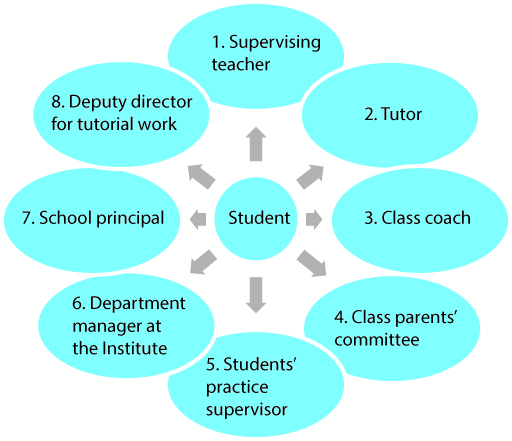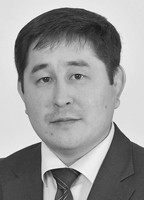Rural teaching practice for physical culture university students: regional design and educational and practical provisions
Фотографии:
ˑ:
N.N. Sivtsev
Churapcha State Institute of Physical Culture and Sports, Churapcha, Republic of Sakha (Yakutia)
Keywords: teaching practice, regional model, practical training, educational process, professional skills.
Background. Experience has proven that the genetically predetermined safety factors and biological resources they are based on, however high they may be, are not always sufficient for living in the extreme Northern climatic conditions, and this is the reason why the schoolchildren raised in the Far North need so much to be highly physically active. Standard school physical education curricula need to be customised to the local conditions with the relevant adapted educational technologies being applied and duly supported by the relevant regulatory provisions in application to the school education establishments operating in the extreme conditions of the Far North.
The relevant teaching practices of the physical culture university students need to be customised to the regional specifics of the Yakut (Sakha) Republic, and a due background is required for the variable part of the national regional component of the curricula – i.e. students need to be duly trained for the rural teaching practice, with the training process being driven by the relevant practical training model that is to be developed.
Objective of the study was to complement the academic education process by a regional education process model (with the relevant design and practical education provisions) of the rural training practice of physical culture university students.
Methods and structure of the study. The study was performed at the premises of Churapcha State Institute of Physical Culture (CSIPC) of the Yakut (Sakha) Republic. Subject to the study were 180 full-time first-to-fourth-year students of the Physical Culture Institute. To rate the permanent teaching practice efficiency, we conducted a questionnaire survey of 180 students, with the questions designed to rate their competences for the effective professional careers; have their views on the role of the perceived teaching practice and its contribution to the academic education; and identify the key components of their fitness for future professional career.
The teaching practice model was designed on the assumption that it should notably improve the education quality at the Institute; step up the competitiveness of the trainees as future physical education specialists and coaches acting in the actual market environments. The permanent teaching practice is viewed as a pivotal component of future profession.
Teaching practice model design

|
Activity components |
Goal |
Forms of activity |
|
1. Introduction 2. Planning 3. Teamwork 4. Psychological examinations of students 5. Summing-up 6. Reporting
|
1. Practical support from experienced teaches 2. Practical teaching skills mastering by students 3. Cooperative teaching model applying skills |
1. Lessons, training sessions, self-training, class activity 2. Assistance to off-class activity supervisor 3. Assistance to the coach responsible for mass sport and health events 4. Support for students’ leisure time management activity 5. Individual work with students 6. Psychological examinations of students 7. Off-class activity, sport competitions, class trainings, self-trainings 8. Students’ leisure time design 9. Hikes, excursions, meetings, disputes 10. Delinquency prevention activities 11. Refereeing services in sport competitions 12. Open-door events |
Churapcha State Institute of Physical Culture (CSIPC): academic education process chart
Attending and giving practical Physical Education lessons to students
Summer camp practice as a tutor or instructor
Field practice
We have identified and studied the practicing students’ teaching skills of professional importance and applied the relevant competences rating system. Using a set of criteria to rate the students’ professionally important teaching skills and competences, we thereby assessed their practical fitness for professional careers, with a special emphasis on the cognitive, constructive and managerial competences.
Study results and discussion. The questionnaire survey data included the students’ self-rates of their own fitness for the teaching practice, with 50% of the first-year students rating their fitness high; 25% average; and 25% low or unconfident in their self-rating. The second-year students self-rated their own fitness rates for the teaching practice as follows: 60% high; 30% average; and 10% low. And the third-year students self-rated their fitness for the teaching practice as follows: 80% high; 20% average; no one of the students rated him/herself unfit for the practice. The forth-year students self-rated their fitness for the teaching practice as follows: 90% high; and 10% average.
It should be noted that 80% of the respondents underlined the importance of the special training stage in preparation for the teaching practice and appreciated the efficiency of the permanent teaching practice model versus the traditional intermitted focused practice model. Expert opinion poll, with top-professional specialists and employers being subject to the poll on the practicing students’ fitness for the professional responsibilities, yielded a unanimous opinion on the existing teaching practice model being in need of urgent revision in terms of design, content and procedures.
Practicing students’ professional teaching competences rating study report
The first rating data array was obtained in the academic year of 2014-15 for the third-year students; and the second rating data array was obtained in the academic year of 2015-16 again for the third-year students. The permanent teaching practice model was applied to the first-to-forth-year students of Churapcha State Institute of Physical Culture and Sports.
The cognitive component of the Study Group students’ professional competences showed progress with the optimal level tested to grow by 12.1%, acceptable level by 10%, critical level tested to drop by 19.3 %, and the inacceptable level by 9%; versus the Reference Group students whose professional competences also showed progress with the optimal level tested to grow by 4.2%, acceptable level by 5.9%, critical level tested to drop by 6.9%, and the inacceptable level to drop by 3.2%.
The professional cognitive component maturity levels of the Study Group students were rated as follows: 3.5% optimal; 3.3% acceptable; 2.2% critical; and 9% inacceptable; versus the Reference Group students data of 4.3% optimal level; 0.6% acceptable level; 2.9% critical level; and 2% inacceptable level.
The constructive component of the Study Group students’ professional competences was tested to grow by 3.5%, the acceptable level by 3.3%, the critical level dropped by 2.2%, and the inacceptable level dropped by 9%; versus the Reference Group students with the optimal and acceptable levels tested to grow by 4.3% and 0.6% respectively, the critical and inacceptable levels to drop by 2.9% and 2% respectively.
The professional managerial component of the Study Group students’ professional competences under the experimental teaching practice model was tested to grow by 2%; the acceptable level remained the same, the critical level grew by 2%, and the inacceptable level dropped by 4%; versus the Reference Group students with the optimal and acceptable levels tested to grow by 1%, the critical level remaining the same; and the inacceptable level dropped by 2%.
Conclusion. The students’ professional teaching competences rating method makes it possible to fairly rate their fitness for the future professional responsibilities. To ensure further progress of the proposed teaching practice model, the educational and procedural contents of the model need to be advanced and new components should be developed for the model to effectively build up the relevant professional teaching competences and skills pivotal for the educational process success at municipal and rural general education schools.
References
- Karpushin B.A. Pedagogicheskie osnovy vospitatelnoy deyatelnosti pri zanyatiyakh fizicheskoy kulturoy i sportom. Ucheb. posobie [Pedagogical basics of educational activity at physical education and sports sessions. Study guide]. St. Petersburg: Lesgaft SPbSAPC publ., 2003, 99 p.
- Kuzmina N.V., Rean A.A. Professionalizm pedagogicheskoy deyatelnosti. Metod posobie [Professionalism of teaching activities. Guide]. Rybinsk, 1993, 54 p.
- Kulikova L.M. Modernizatsiya soderzhaniya i organizatsii nepreryivnoy pedagogicheskoy praktiki v fizkulturnom vuze [Modernization of content and procedure of continuous teaching practice in physical culture university]. Moscow: Teoriya i praktika fiz. kultury, 2004, 268 p.
- Lukyanenko E.Y. Formirovanie sotsialno-professionalnoy kompetentnosti studentov fakulteta fizicheskoy kultury [Formation of socio-professional competency in physical education faculty students]. Uchenye zapiski un-ta im. P.F. Lesgafta, 2010, no. 4 (62), p. 51.
- Mikhaylova T.V. Effektivnost podgotovki kadrov v sportivnom vuze v kontekste sotsiologicheskogo analiza [Sport university education efficiency in context of sociological analysis]. Fizicheskaya kultura: vospitanie, obrazovanie, trenirovka, 2016, no. 6, p. 63-65.
- Resheten I.N., Kober I.H., Prokhorova M.V., Abdulov I.T. Osnovy pedagogicheskogo masterstva uchitelya fizicheskoy kultury [Fundamentals of teaching skills of physical education teachers]. Alma-Ata: Radan publ., 1990, 64 p.
Corresponding author: ssvjakutija@yandex.ru
Abstract
The study considers the students’ permanent teaching practice model piloted by regional physical culture university. Issues of the students’ professional developmental practices have long been studied by many researchers since the academic professional education process at a physical culture university gives only theoretical knowledge that needs to be supported by practical skills acquired through actual teaching practices. Therefore, today a high priority should be given to studies to complement the academic education process with a regional teaching practice model (with the relevant design and practical educational provisions) giving the necessary rural teaching practice to physical culture university students. The study was performed at the premises of Churapcha State Institute of Physical Culture (CSIPC) in the Yakut (Sakha) Republic.



